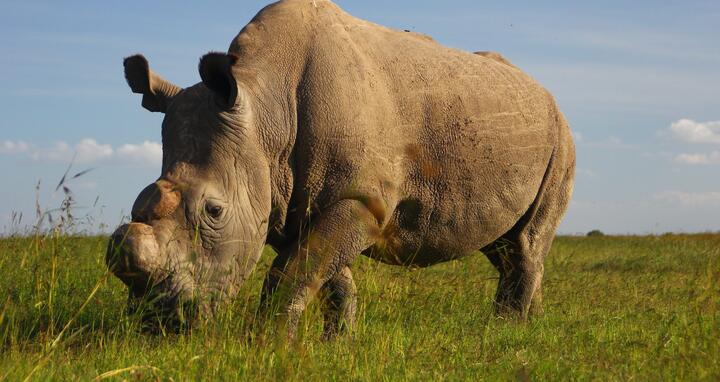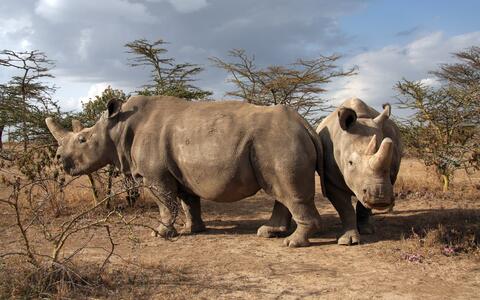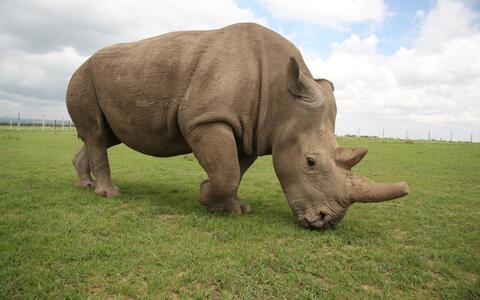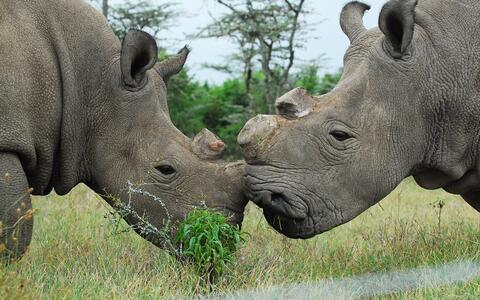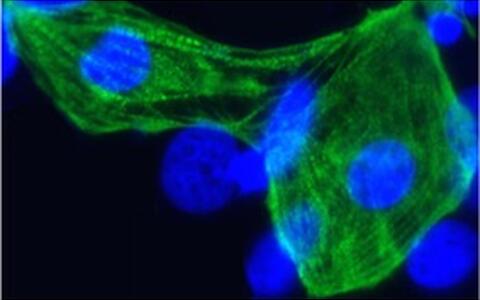COVID-19 versus conservation
COVID-19 hampered communication and travels, prevented or delayed crucial procedures, caused losses in revenues and by that may have lowered the chances of a survival of the northern white rhino. However, the consortium adjusted strategies, gained valuable knowledge during these challenging times and continued with its mission. The team describe the effects of the pandemic on the BioRescue project in detail in the “Journal of Applied Animal Ethics Research”.
There are only two northern white rhino individuals left in the world, both females. To prevent the extinction of this species, an international consortium of scientists and conservationists seeks to advance assisted reproduction techniques and stem-cell associated technologies to create northern white rhino embryos in-vitro. In the near future, the embryos will be transferred to southern white rhino surrogate mothers.
This boundary-pushing programme is conducted by an international team working within a global framework and includes scientists and conservationists from institutions in Germany, Kenya, Japan, Czech Republic, USA and Italy. From March 2020 onwards, the work of the consortium has been severely affected by the COVID-19 pandemic in several ways at the local, national and international level.
The collection of oocytes was delayed
At the international level, the most striking obstacle were international travel restrictions. “The consortium partners had previously agreed upon collecting oocytes from the last two northern white rhinos every three to four months,” says BioRescue project head Professor Thomas Hildebrandt from the Leibniz-Institute for Zoo and Wildlife Research (Leibniz-IZW). “This is considered a safe interval to maintain the health of the females while maximising the number of harvested oocytes, equivalent to potential future embryos and offspring.”
Following such an interval, oocyte collection was planned for March 2020 at the Ol Pejeta Conservancy in Kenya. “Owing to international travel restrictions, the procedure had to be cancelled and could only be conducted after the re-opening of Kenya’s borders in August 2020,” adds Leibniz-IZW BioRescue scientist Dr. Susanne Holtze, who shares first authorship of the publication with Hildebrandt. “This does not only mean that one crucial opportunity was missed and possibly several valuable embryos could not be generated, it also affected the subsequent procedure in August 2020.”
It is likely that the prolonged interval since the last oocyte collection in December 2019 compromised oocyte quality and was the reason that out of ten oocytes, no embryos could be created. The delay of possible embryo transfers in Kenya will also decrease chances for northern white rhino calves to grow up with individuals of their kind.
Noticeable drop in revenue
This ultimately implies that almost a year was lost for the programme – a serious delay in the race against time to prevent the extinction of the northern white rhino. “On the other hand, the involuntary break provided us with valuable new insights into the reproduction management of northern white rhinos,” says Hildebrandt. “We still made progress in 2020 as we could successfully continue our research with our Kenya mission in December.”
In addition to the delays in conducting the procedures at Ol Pejeta Conservancy in Kenya, for which strict travel regulations and on-site hygiene rules had to be followed, the pandemic posed several further challenges to the consortium. Lockdown and temporal closures of public facilities caused notable losses in revenues for the consortium partner Safari Park Dvůr Králové in the Czech Republic. “We faced the unprecedented situation of having no revenues from entrance fees and other services. However, against all odds, we were quickly able to develop new ways of how to approach our potential visitors and supporters online and this allowed us to keep our support to the northern white rescue programme on the same level as in previous years. Our highest priority is protecting species from extinction and COVID-19 confirmed how important the support by individual donors is,” says Jan Stejskal, the Safari Park’s Director of Communication and International Projects.
Similarly, the not-for-profit Ol Pejeta Conservancy experienced drastic reductions in revenue from international tourism owing to a ban on international travel, national curfews and the isolation of the capital Nairobi. “Therefore, fundraising was necessary to maintain our wildlife and conservation programmes and pay for salaries,” says Ol Pejeta Managing Director, Richard Vigne. “Nevertheless, safeguarding the animals and professional veterinary care were maintained at all times in cooperation with the Kenya Wildlife Service.”
Work in the laboratory was also more challenging
Staff at labs was limited, hygiene rules were enacted, transportation of samples and equipment were hampered.
For the research facilities of the consortium partners in Germany, Italy and Japan, different levels of restrictions were put in place on laboratory work. Crucial work at Leibniz-IZW, Avantea Laboratory of Reproductive Technologies (Italy), Kyushu University (Japan) and the Max Delbrück Center for Molecular Medicine (Germany) could be carried on to a limited extent. “Staff at labs was limited, hygiene rules were enacted, transportation of samples and equipment were hampered and last but not least closure of schools and child care facilities forced parents to switch from lab work to mobile work at home,” Dr. Sebastian Diecke from Max Delbrück Center sums up.
Laboratories and offices at the University of Padova were also closed and online-teaching and research was implemented. The team in charge of the ethical monitoring of the BioRescue programme continued working from home, and had to adjust strategies to carry on the ethical assessment for all procedures. “Despite all difficulties, the ethical assessment was always performed and BioRescue procedures have uninterruptedly maintained high standards of quality and respect for the safety and welfare of both researchers and the animals involved,” says Dr. Barbara de Mori from University of Padua.
“COVID-19 has disastrous consequences all over the world, but two new embryos that we produced in December 2020 demonstrate that our BioRescue team is committed to overcome all scientific and logistic challenges the northern white rhino rescue might bring. We will be grateful for everyone who decides to support us in our mission,” adds Jan Stejskal.
Restoring destroyed habitats
Besides the downside effects of the pandemic, there were also a few positive ones. For example, closure of international borders opened up new opportunities for assisted reproduction procedures in Germany which were important for advancing and perfecting methods and techniques. For example, a designated mating partner of a southern white rhino female in a German zoo could not be transferred and therefore, assisted reproduction was a welcome alternative to regular natural mating.
Secondly, social distancing regulations helped to establish a new culture of online meetings within the consortium partners on a more regular basis, which proved useful and will continue in future. Lastly, there is a renewed awareness for the destruction of habitat and the loss of biodiversity as key drivers for emerging zoonotic diseases.
“BioRescue is not only about saving the northern white rhino. On the long run it also is a much-needed step for the healing of disrupted habitat in Central Africa and therefor for preventing global pandemics in future,” says Thomas Hildebrandt. “It is ironic and bitter, that our mission was severely affected by the very thing it ultimately intends to make more unlikely, a pandemic.”
Text: Leibniz-IZW
Further information
Literature
Thomas Hildebrandt, Susanne Holtze et al. (2021): „Conservation Research in Times of Covid-19 – the Rescue of the Northern White Rhino”, Journal of Applied Animal Ethics Research. DOI: 10.1163/25889567-BJA10009

